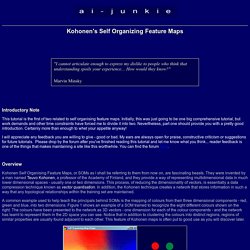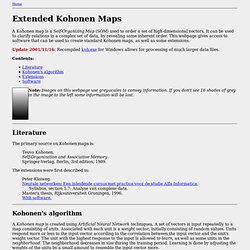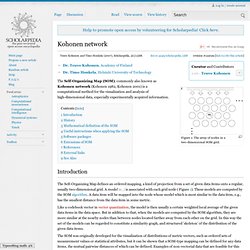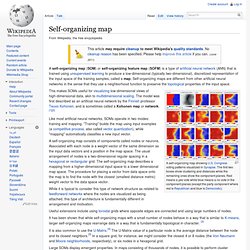

Self-Organizing Feature Maps (Kohonen maps) Glossary SO(F)M - Self-Organizing (Feature) Maps (A)NN – (Artificial) Neural Network Introduction Self-Organizing Feature maps are competitive neural networks in which neurons are organized in a two-dimensional grid (in the most simple case) representing the feature space.

According to the learning rule, vectors that are similar to each other in the multidimensional space will be similar in the two-dimensional space. SOFMs are often used just to visualize an n-dimensional space, but its main application is data classification. Data classification Suppose we have a set of n-dimensional vectors describing some objects (for example, cars). The architecture of SOFM The SOFM NN consists of two layers of neurons (Fig. 1).
Fig. 1. Learning rule In the beginning of the functioning, all weights vectors of the second layer’s neurons are set to random values. Where, i and j are the indices of neurons in the output layer. Here, k1 and k2 are indices of the winner-neuron. SOM with Conscience.pdf. Shyam Guthikonda Kohonen SOM.pdf. Kohonen SOM for Traveling Salesman problem.pdf. SOM.c. SOM tutorial. Kohonen's Self Organizing Feature Maps Introductory Note This tutorial is the first of two related to self organising feature maps.

Initially, this was just going to be one big comprehensive tutorial, but work demands and other time constraints have forced me to divide it into two. Nevertheless, part one should provide you with a pretty good introduction. Certainly more than enough to whet your appetite anyway! I will appreciate any feedback you are willing to give - good or bad. Overview Kohonen Self Organising Feature Maps, or SOMs as I shall be referring to them from now on, are fascinating beasts. A common example used to help teach the principals behind SOMs is the mapping of colours from their three dimensional components - red, green and blue, into two dimensions. Figure 1 Screenshot of the demo program (left) and the colours it has classified (right). One of the most interesting aspects of SOMs is that they learn to classify data without supervision. Network Architecture Figure 2. Extended Kohonen Maps. Home A Kohonen map is a Self-Organizing Map (SOM) used to order a set of high-dimensional vectors.

It can be used to clarify relations in a complex set of data, by revealing some inherent order. This webpage gives access to software that can be used to create standard Kohonen maps, as well as some extensions. Update 2001/11/16: Recompiled koh.exe for Windows allows for processing of much larger data files. Contents: Note: Images on this webpage use grey-scales to convey information.
Literature. Kohonen Networks.pdf. Package kohonen. Kohonen Networks. Kohonen Networks Introduction In this tutorial you will learn about: Unsupervised Learning Kohonen Networks Learning in Kohonen Networks Unsupervised Learning In all the forms of learning we have met so far the answer that the network is supposed to give for the training examples is known.

Scholarpedia. Figure 1: The array of nodes in a two-dimensional SOM grid.

The Self-Organizing Map (SOM), commonly also known as Kohonen network (Kohonen 1982, Kohonen 2001) is a computational method for the visualization and analysis of high-dimensional data, especially experimentally acquired information. Introduction The Self-Organizing Map defines an ordered mapping, a kind of projection from a set of given data items onto a regular, usually two-dimensional grid. A modelm_i is associated with each grid node ( Figure 1). These models are computed by the SOM algorithm. Like a codebook vector in vector quantization, the model is then usually a certain weighted local average of the given data items in the data space. History The SOM algorithm grew out of early neural network models, especially models of associative memory and adaptive learning (cf.
Figure 2: Left image: Models of acoustic spectra of Finnish phonemes, organized on an SOM. Mathematical definition of the SOM Software packages References. Wikipedia. A self-organizing map (SOM) or self-organizing feature map (SOFM) is a type of artificial neural network (ANN) that is trained using unsupervised learning to produce a low-dimensional (typically two-dimensional), discretized representation of the input space of the training samples, called a map.

Self-organizing maps are different from other artificial neural networks in the sense that they use a neighborhood function to preserve the topological properties of the input space. This makes SOMs useful for visualizing low-dimensional views of high-dimensional data, akin to multidimensional scaling. The model was first described as an artificial neural network by the Finnish professor Teuvo Kohonen, and is sometimes called a Kohonen map or network.[1][2] Like most artificial neural networks, SOMs operate in two modes: training and mapping.
Teuvo Kohonen. Teuvo Kohonen (born July 11, 1934) is a prominent Finnish academician (Dr.

Eng.) and researcher. He is currently professor emeritus of the Academy of Finland. Prof. Kohonen has made many contributions to the field of artificial neural networks, including the Learning Vector Quantization algorithm, fundamental theories of distributed associative memory and optimal associative mappings, the learning subspace method and novel algorithms for symbol processing like redundant hash addressing. He has published several books and over 300 peer-reviewed papers. Most of his career, Prof. Teuvo Kohonen was elected the First Vice President of the International Association for Pattern Recognition from 1982 to 1984, and acted as the first president of the European Neural Network Society from 1991 to 1992. For his scientific achievements, Prof. Bibliography[edit] External links[edit]